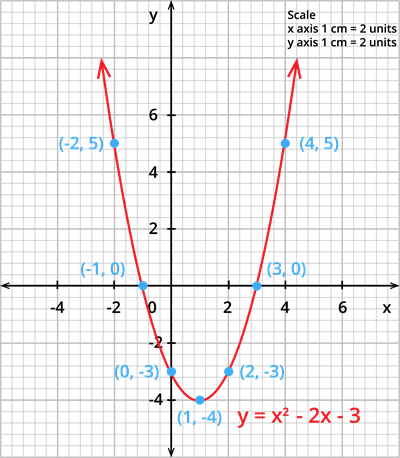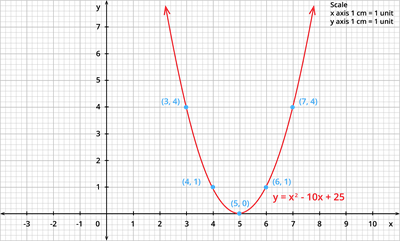
PUMPA - SMART LEARNING
எங்கள் ஆசிரியர்களுடன் 1-ஆன்-1 ஆலோசனை நேரத்தைப் பெறுங்கள். டாப்பர் ஆவதற்கு நாங்கள் பயிற்சி அளிப்போம்
Book Free DemoLet us discuss how to determine the nature of the solutions for the given quadratic equations.
Example:
1. Find the nature of the solution of the equation y = x^2 - 2x - 3.
Solution:
Step 1: Draw the graph of the equation y = x^2 - 2x - 3.
The table of values for the equation y = x^2 - 2x - 3 is:
| x | -2 | -1 | 0 | 1 | 2 | 3 | 4 |
| x^2 | 4 | 1 | 0 | 1 | 4 | 9 | 16 |
| 2x | -4 | -2 | 0 | 2 | 4 | 6 | 8 |
| 3 | 3 | 3 | 3 | 3 | 3 | 3 | 3 |
| y | 5 | 0 | -3 | -4 | -3 | 0 | 5 |
Step 2: Plot the points in the graph using a suitable scale.

Step 3: Join the points by a smooth curve.
Step 4: In the graph, observe that the curve intersects the X - axis at 2 points (-1,0) and (3,0). Therefore, the roots of the equation are -1 and 3.
Since there are two points of intersection with the X - axis, the given equation has real and unequal roots.
2. Find the nature of the solutions of the equation y = x^2 - 10x + 25.
Solution:
Step 1: Draw the graph of the equation y = x^2 - 10x + 25.
The table of values for the equation y = x^2 - 10x + 25 is given by:
| x | 3 | 4 | 5 | 6 | 7 |
| x^2 | 9 | 16 | 25 | 36 | 49 |
| 10x | 30 | 40 | 50 | 60 | 70 |
| 25 | 25 | 25 | 25 | 25 | 25 |
| y | 4 | 1 | 0 | 1 | 4 |
Step 2: Plot the points in the graph.

Step 3: Join the points by a smooth curve.
Step 4: Here, the curve meets the X - axis at only one point. Therefore, the point of intersection of the parabola with X - axis for the given equation is (5,0).
Since the point of intersection is only one point with X - axis, the given quadratic equation has real and equal roots.